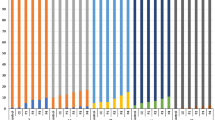Abstract
Praziquantel is an anthelmintic active against trematodes and cestodes. The absorption, distribution and excretion of the drug was studied in serum, muscles, liver, bile fluid and kidneys of rainbow trout at two temperatures, 12‡ C and 18‡ C, after a single oral dose of 500 mg/kg body wt. A bioassay, using cercaria larvae of the trematodeDiplostomum spathaceum as the test organism, was employed to measure the drug levels in tissues of the fish. The cercariae were very sensitive to praziquantel; their mobility was significantly reduced within 20 min in a 0.01 Μg/ml solution.
Praziquantel was readily absorbed from the gastrointestinal tract of the fish. Absorption was more rapid at 18‡ C than at 12‡ C. Only in the liver, however, did the peak values reach significantly higher levels at the higher temperature. The peak values in different tissues (10.2–31.8 Μg/g) were reached 4–16 h after administration of the drug. The elimination of the drug from the tissues was less dependent on temperature than absorption. By 32 h p.a., 67%–96% of the maximum amounts had been eliminated from the tissues. Praziquantel was excreted partly with bile fluid and partly as water-soluble metabolites through the kidneys.
Similar content being viewed by others
References
Andrews C, Riley A (1982) Anthelmintic treatment of fish via stomach tube. Fish Mgmt 13:83–84
Andrews P (1976) Pharmakokinetische Tieruntersuchungen mit Droncit unter Verwendung einer biologischen Prüfmethode. Vet Med Nachrichten 2:154–165
Andrews P (1978) Effect of praziquantel on the free-living stages ofSchistosoma mansoni. Z Parasitenkd 56:99–106
Andrews P, Thomas H, Pohlke R, Seubert J (1983) Praziquantel. Med Res Rev 3:147–200
Becker B, Mehlhorn H, Andrews P, Thomas H, Eckert J (1980) Light and electron microscopic studies on the effect of praziquantel onSchistosoma mansoni, Dicrocoelium dendriticum andFasciola hepatica (Trematoda) in vitro. Z Parasitenkd 63:113–128
Becker B, Mehlhorn H, Andrews P, Thomas H (1981) Ultrastructural investigations on the effect of praziquantel on the tegument of five species of cestodes. Z Parasitenkd 64:257–269
Bylund G, Sumari O (1981) Laboratory tests with Droncit against diplostomiasis in rainbow trout,Salmo gairdneri Richardson. J Fish Dis 4:259–264
Diekmann H (1979) Quantitative determination of praziquantel in body fluids by gas liquid chromatography. Eur J Drug Metab Pharmacokin 4:139–141
Diekmann H, Bühring K (1976) The fate of praziquantel in the organism. III. Metabolism in rat, beagle dog and rhesus monkey. Eur J Metab Pharmacokin 2:107–112
Gönnert R, Andrews P (1977) Praziquantel, a new broad-spectrum antischistosomal agent. Z Parasitenkd 52:129–150
Groll E (1984) Praziquantel. Adv Pharmacol Chemoth 20:219–238
Leopold G, Ungethüm W, Groll E, Diekmann H, Nowak H, Wegner L (1978) Clinical pharmacology in normal volunteers of praziquantel, a new drug against schistosomes and cestodes. Eur J Clin Pharmacol 14:281–291
Patzschke K, Pütter J, Wegner L, Horster F, Diekmann H (1979) Serum concentrations and renal excretion in humans after oral administration of praziquantel — results of three determination methods. Eur J Drug Metab Pharmacokin 4:149–156
Pool D, Ryder K, Andrews C (1984) The control ofBothriocephalus acheilognathi in grass carpCtenopharyngodon idella using praziquantel. Fish Mgmt 15:31–33
Schmahl G, Mehlhorn H (1985) Treatment of fish parasites 1. Praziquantel effective against Monogenea (Dactylogyrus vastator, Dactylogyrus extensus, Diplozoon paradoxum). Z Parasitenkd 71:727–737
Shaw M, Erasmus D (1983)Schistosoma mansoni: dose-related tegumental surface changes after in vivo treatment with praziquantel. Z Parasitenkd 69:643–653
Steiner K, Garbe A (1976) The fate of praziquantel in the organism. II. Distribution in rats. Eur J Drug Metab Pharmacokin 2:97–106
Steiner K, Garbe A, Diekmann H, Nowak H (1976) The fate of praziquantel in the organism. I. Pharmacokinetics in animals. Eur J Metab Pharmacokin 2:85–95
Xiao S-H, Catto B, Webster L (1983) Quantitative determination of praziquantel in serum by high performance liquid chromatography. J Chromatogr 275:127–132
Author information
Authors and Affiliations
Rights and permissions
About this article
Cite this article
Björklund, H., Bylund, G. Absorption, distribution and excretion of the anthelmintic praziquantel (Droncit) in rainbow trout (Salmo gairdneri R.). Parasitol Res 73, 240–244 (1987). https://doi.org/10.1007/BF00578511
Accepted:
Issue Date:
DOI: https://doi.org/10.1007/BF00578511




